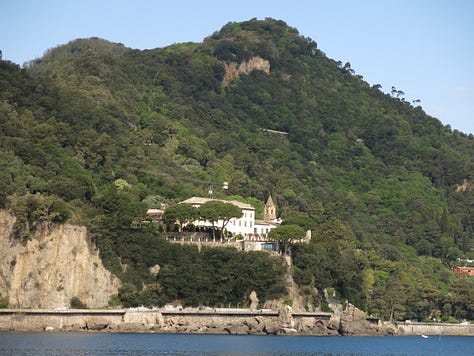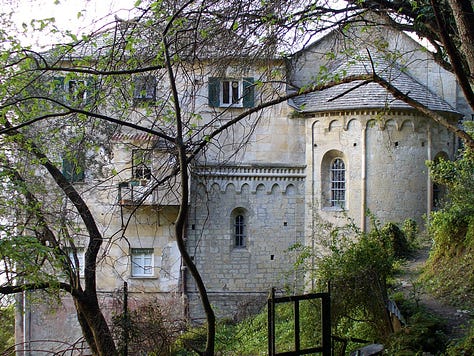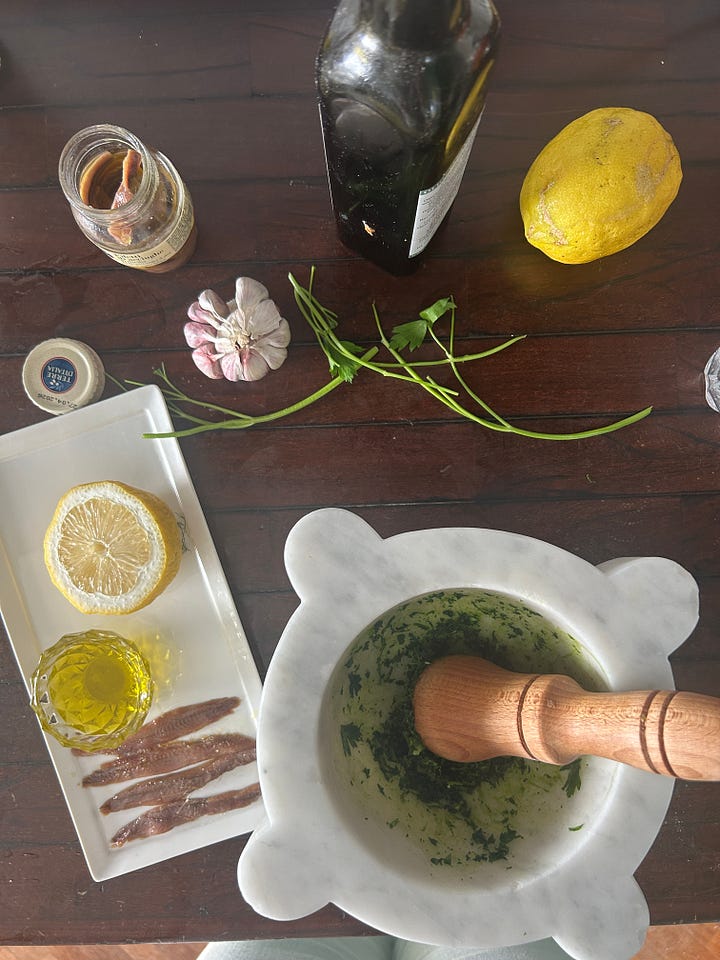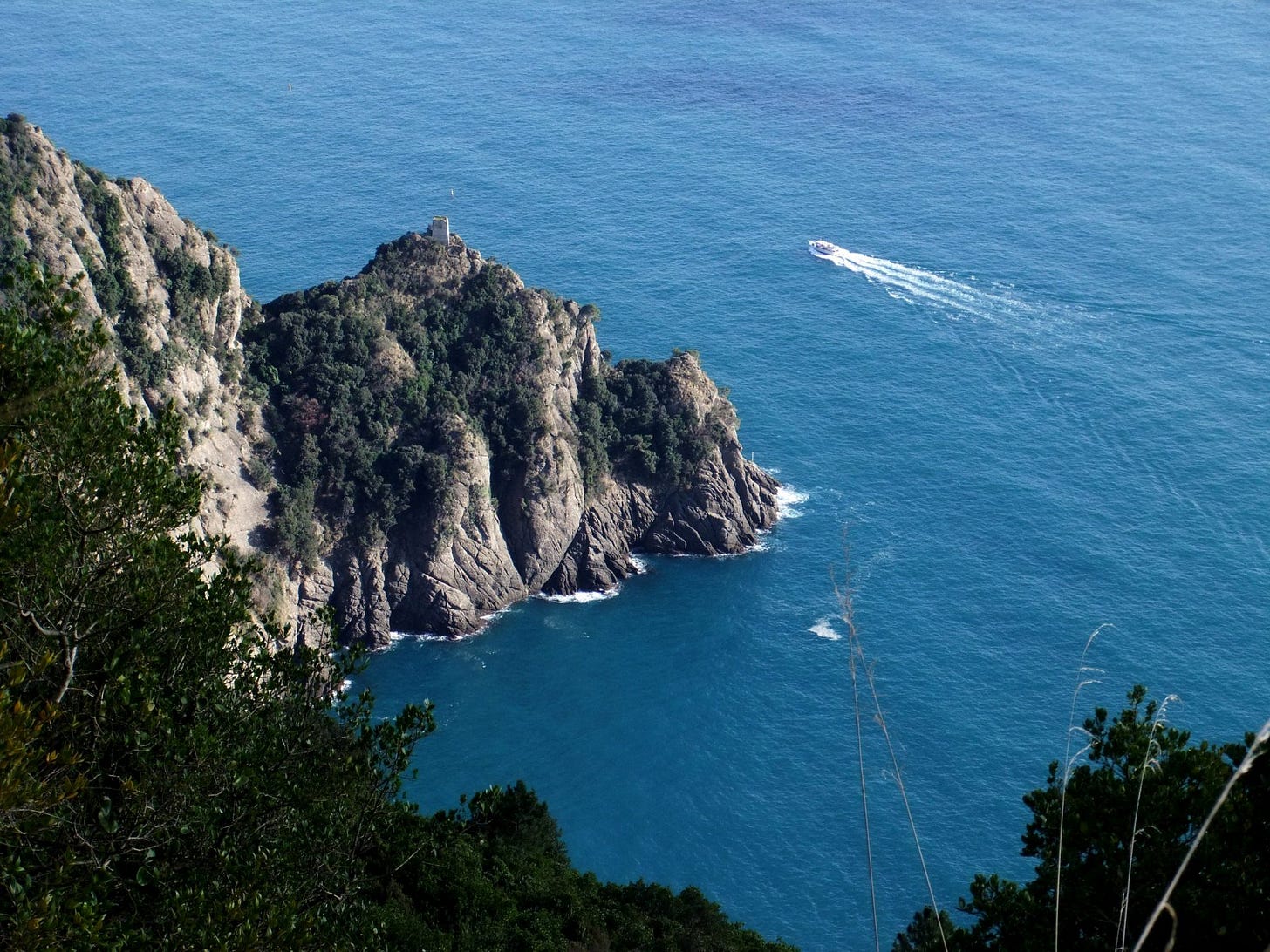Between faith and flavor: the lean cuisine of the mount of Portofino
Where the culture of limits becomes a mark of identity. Two herb pesto recipes and a Liguria online cooking class at Milk Street cooking school.
Ciao!
Today I’d like to take you on a journey back in time, to discover a part of Ligurian cuisine that was born in silence, prayer, and the rugged soil of our land.
It’s called lean cuisine—a way of cooking shaped over centuries by Christian tradition.
Not a story of deprivation, but of spiritual discipline and a culture of meaningful limits.
This tradition found one of its most extraordinary expressions on the Portofino Promontory, a rugged outcrop of land between sea and sky, home to monasteries, terraced gardens, and a way of life shaped by silence, devotion, and the seasons.
Lean cuisine in Christian tradition
Rooted in the ascetic teachings of Christianity, magro cuisine excluded meat and, in stricter times, also eggs and dairy. These were not modern dietary restrictions, but rather a moral and symbolic choice tied to fasting, repentance, and the liturgical calendar. As food historian Massimo Montanari reminds us, in Christianity “eating well is a religious duty,” and limits are not about deprivation, but about meaning.
Monasteries: where spirit and gastronomy meet
Throughout the Middle Ages, monastic communities were custodians of both spiritual and culinary knowledge. Orders like the Benedictines, Carthusians, and Minims embraced a radical simplicity, not just in prayer, but also in diet. For the Minims—founded by Saint Francis of Paola in the 15th century—this meant lifelong abstinence from meat, dairy, eggs, and even butter: what they called the strictest lean.
In their kitchens, food was treated with the same care as scripture. Monasteries became centers of agricultural innovation and culinary memory. Recipes were recorded, preserved, and passed down, reflecting not just what was available, but what was ethically and spiritually appropriate.
Liguria: a land made for “magro”
Liguria’s landscape—steep hills, rocky soil, and narrow terraces—made it a land of limits. But those very constraints shaped a unique culinary wisdom. With little fields and few resources for livestock, the region relied on olive oil, legumes, seasonal vegetables, wild herbs, and the scarce bounty of the sea.
Here, magro was not just a religious observance. It became a way of life, a culinary identity. The mortar replaced the frying pan, herbs replaced meat, and flavor was coaxed from simplicity. Anchovies, preserved in salt, lent depth to sauces and soups. Pine nuts, garlic, capers, and breadcrumbs became the building blocks of a cuisine both humble and bold.
As food historian Massimo Montanari reminds us, “Where the culture of limits is internalized, it becomes a culture of identity.” In Liguria, magro is not austerity—it is mastery.



The abbeys of the Mount of Portofino
On the cliffs of the Portofino Promontory, three monastic sites stand as testaments to this sacred and edible history: La Cervara in Paraggi, the sea-facing Abbey of San Fruttuoso, and the often-overlooked Abbey of San Nicolò di Capodimonte.
The latter, perched between San Rocco di Camogli and Punta Chiappa, was home to Canon Regulars from Avignon and later entrusted to the Minims. It was here, in the 1870s, that a remarkable man lived and wrote: Father Gaspare Dellepiane.
Father Delle Piane and the art of “Strettissimo Magro”
Born in Genoa in 1828, Father Gaspare Delle Piane (originally Stanislao Dellepiane) was a theologian, physician, and keen gastronome. During his time at San Nicolò, he compiled a recipe book unlike any other: La cucina di strettissimo magro senza carne, uova, latte, burro e formaggi (“The Strictest Lean Cuisine Without Meat, Eggs, Milk, Butter or Cheese”), published in 1880.
His book contains 476 recipes that follow the rules of the Minim order. There is no meat, no dairy, and no indulgence—but also no lack of flavor. Divided by season, the recipes reflect the agricultural rhythm of the monastery: chard, potatoes, onions, squash, legumes, and an abundance of fresh and dried herbs like thyme, marjoram, rosemary, and sage.
Central to Delle Piane’s cuisine is extra virgin olive oil—harvested from the hills of Eastern Liguria. More than a condiment, it is a symbol of purity and light.
Anchovies, salt-cured and rich in umami, replace broths and meat fats. With these ingredients, the friars crafted soups, herb pestos, stews, and savory pies that nourished body and soul.
Dellepiane’s cooking is ethical, seasonal, local, and deeply Ligurian. But it is also profoundly European: a reminder that food can be both sustenance and scripture.


The mortar: more than a tool
At the heart of this culinary world stands a simple yet powerful tool: the mortar.
In Liguria, it's made of marble, with a wooden pestle of olive wood. In monastic kitchens, it was used daily to prepare agliata, walnut sauce, herb pestos, and anchovy condiments.
For medieval cooks, the act of grinding was both technical and sacred. It didn’t cut, but united. It didn’t cook, but transformed. The mortar brought harmony to disparate ingredients—just as monastic life brought harmony to individual lives. It required patience, rhythm, and care: the same values that guided spiritual practice.
A living tradition
The cuisine of magro is not just a relic of the past. In an age that values plant-based diets, seasonality, and sustainability, the lessons of Padre delle Piane feel more relevant than ever. It teaches us that flavor doesn’t come from excess—but from knowledge, attention, and care.
So the next time you crush herbs in a mortar, drizzle olive oil over vegetables, or stir anchovies into a stew, remember the monks of the Portofino mountain—and the taste of a faith made edible.
But before I share the recipes with you…
🧄 Join me for a summer online cooking class!
I’m pleased to announce you that I will be teaching an online Ligurian cooking class hosted by the amazing Milk Street Cooking School!
We will prepare the super traditional “Lasagne al pesto” (here Mandilli de Seae, in dialect) and the iconic summer go-to recipe Polpettone with potatoes and greenbeans.
It’s this Saturday, June 28 at 1:00pm EST / 10:00am PST / 7:00pm CET
For you there is a special 15% off, just use the code ENRICA15
Two pesto recipes from the wisdom of Padre Delle Piane.
I’m sharing with you two “cold sauces” made in the mortar, taken from Father Dellepiane’s 1880 recipe book.
As the book suggests, these sauces were meant to accompany
“boiled meats, vegetables, crostini, and side dishes.”
There are sixteen of them in total. These two stood out as the most intriguing—and the most delicious.
🥕 Carrot Sauce
30 g green olives (pitted)
20 g capers
20 g pine nuts
2 salt-cured anchovies (cleaned and deboned)
2 boiled carrots
2 tablespoons vinegar
6 tablespoons olive oil
Salt, to taste
Pound the olives, capers, anchovies, pine nuts, and boiled carrots in a mortar (or pulse them in a food processor) until you get a smooth paste.
Pass the mixture through a fine sieve for extra silkiness, then whisk in the vinegar and olive oil. Taste and adjust the salt. Serve at room temperature.
🌿 Almond and Pine Nut Sauce
30 g blanched almonds (skins removed by soaking in boiling water)
30 g pine nuts
2 salt-cured anchovies (cleaned and deboned)
30 g capers
2 tablespoons vinegar
5 tablespoons olive oil
Salt, to taste
Crush the almonds in a mortar or blend until finely ground. Add the pine nuts and anchovies, and keep pounding (or blending) until the mixture becomes a smooth paste.
Pass it through a sieve if you like it silky. Stir in the vinegar and olive oil. Finally, add the capers—either whole or gently crushed. Taste, adjust seasoning, and serve.
And that’s all! Happy cooking!
Enrica






Fascinating!
Loved this essay- the intertwining of faith, tradition and place enabling food that satisfies while being sustainable and not gluttonous or destructive- the lessons here are deep. Thank you!